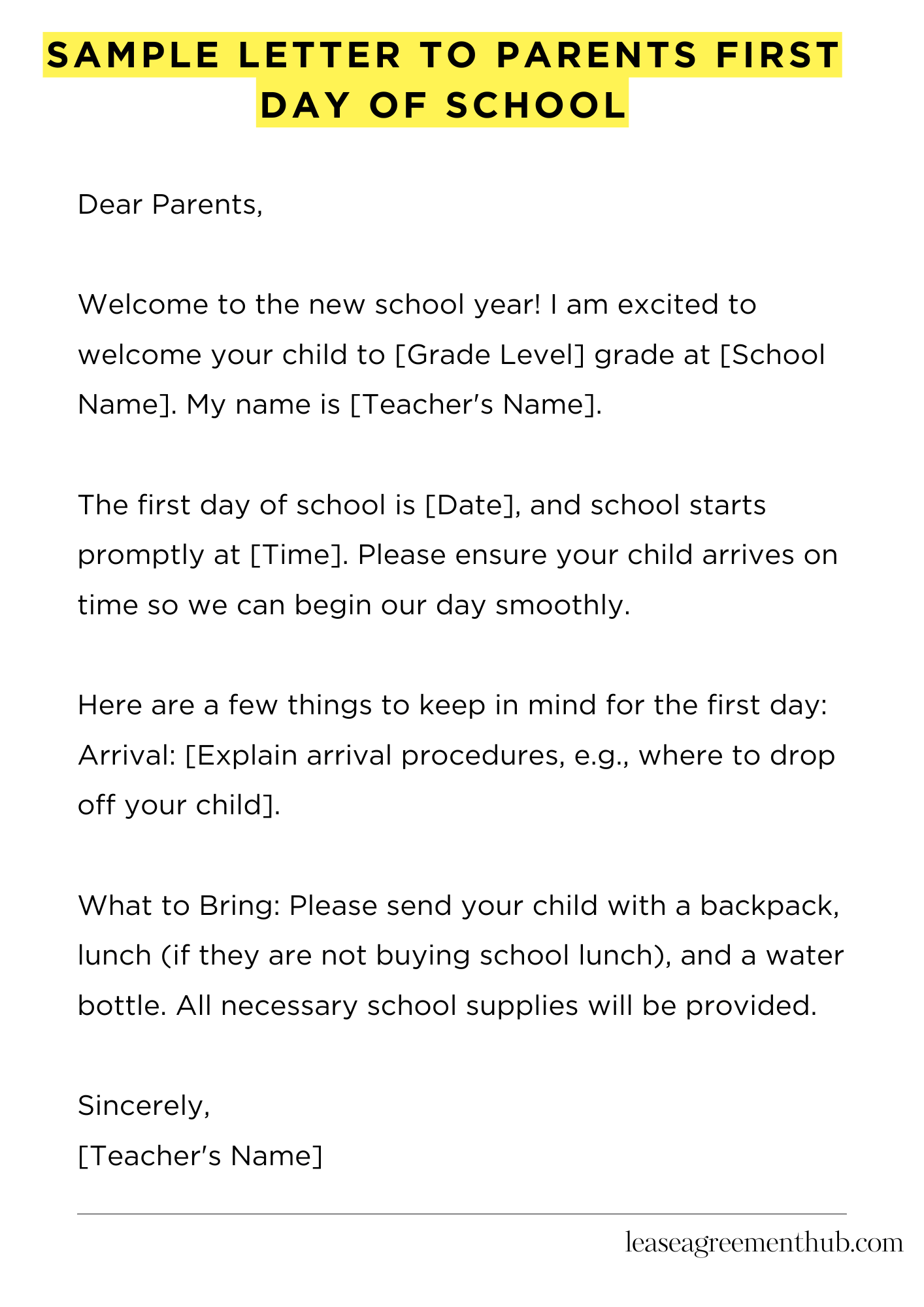A “Sample Letter To Parents First Day Of School” is a note sent by teachers or schools. It informs parents about the upcoming school year. It’s often needed when starting a new academic year.
Need to write one? We get it. Crafting the perfect letter can be tricky.
That’s why we’re sharing templates and examples. These samples make writing your letter easy. Let’s dive in!
Sample Letter To Parents First Day Of School
[Date]
Dear Parents,
Welcome to the new school year! I am excited to welcome your child to [Grade Level] grade at [School Name]. My name is [Teacher’s Name], and I will be your child’s teacher this year.
The first day of school is [Date], and school starts promptly at [Time]. Please ensure your child arrives on time so we can begin our day smoothly.
Here are a few things to keep in mind for the first day:
Arrival: [Explain arrival procedures, e.g., where to drop off your child].
What to Bring: Please send your child with a backpack, lunch (if they are not buying school lunch), and a water bottle. All necessary school supplies will be provided.
Dismissal: [Explain dismissal procedures, e.g., where to pick up your child]. Please inform me in advance how your child will be getting home.
I believe that communication between school and home is essential for your child’s success. I will be sending out regular updates via [Communication Method, e.g., email, class website]. Please feel free to contact me with any questions or concerns at [Email Address] or [Phone Number].
I look forward to a wonderful year of learning and growth with your child!
Sincerely,
[Teacher’s Name]

How to Write Letter To Parents First Day Of School
Subject Line: Compel Them to Open
- Craft a subject line that begs to be opened. “Welcome to [Grade Level]!” or “Excited to Partner With You” are good springboards.
- Be succinct. Brevity piques curiosity; unnecessary verbosity repels.
- Personalize it, if feasible. “A Warm Welcome, [Parent’s Last Name] Family!” adds a personal touch.
Salutation: Setting the Tone
- Begin with a cordial greeting. “Dear Parents” is always a safe harbor, but consider “Esteemed Parents” for a touch of formality.
- If you know the parents’ names, leverage that advantage. “Dear Mr. and Mrs. [Last Name]” showcases attentiveness.
- Avoid overly casual greetings. Remember, you’re establishing a professional, collaborative rapport.
Introduction: Seize Their Attention
- Express your enthusiasm. “I am absolutely thrilled to be your child’s [Grade Level] teacher this year!” exudes positive energy.
- Briefly introduce yourself if this is the first communication. Mention your experience or a relevant credential to establish credibility.
- Outline the letter’s purpose. Let them know what to expect in the forthcoming paragraphs; transparency is paramount.
Body Paragraph 1: Curriculum Sneak Peek
- Offer a tantalizing glimpse into the curriculum. Mention key topics or projects that will be undertaken.
- Highlight the skills students will cultivate. Focus not just on what they’ll learn, but how they’ll grow.
- Avoid drowning them in specifics. Maintain a high-level overview to whet their appetite for more.
Body Paragraph 2: Classroom Expectations and Procedures
- Articulate your classroom expectations clearly but kindly. This sets the stage for a structured learning environment.
- Briefly describe essential classroom procedures. How do students submit assignments? What’s the protocol for tardiness?
- Emphasize collaboration. Frame these expectations as a joint effort to support student success.
Call to Action: Encourage Engagement
- Invite parents to reach out with questions or concerns. Open communication is the bedrock of a strong partnership.
- Include your contact information prominently. Email address, phone number, or preferred method of communication should be readily accessible.
- Mention opportunities for parental involvement. Volunteering, classroom visits, or attending school events foster a sense of community.
Closing: Leave a Lasting Impression
- End with a sincere expression of anticipation. “I eagerly anticipate a rewarding school year together” conveys optimism.
- Choose a professional closing. “Sincerely,” “Respectfully,” or “Warmly” are all appropriate options.
- Sign off with your name and title. This reinforces your role and provides clarity.
Frequently Asked Questions: First Day of School Parent Letter
This section addresses common queries regarding the first day of school parent letter. It offers guidance on content, purpose, and best practices.
What is the purpose of a first day of school parent letter?
The primary purpose is to establish communication and build rapport with parents, outlining expectations, classroom routines, and contact information for the academic year.
What key information should be included in the letter?
Essential elements include a warm welcome, teacher introduction, classroom policies, daily schedule overview, supply list (if applicable), and contact details.
How formal should the tone of the letter be?
The tone should be professional and friendly, projecting competence and approachability while maintaining a respectful and courteous demeanor.
When should the letter be sent to parents?
Ideally, the letter should be sent a week or two before the first day of school, allowing parents ample time to review the information and prepare accordingly.
Is it necessary to translate the letter into other languages?
If the school serves a diverse community with a significant number of non-English speaking parents, providing translated versions is highly recommended to ensure inclusivity and understanding.
Related: